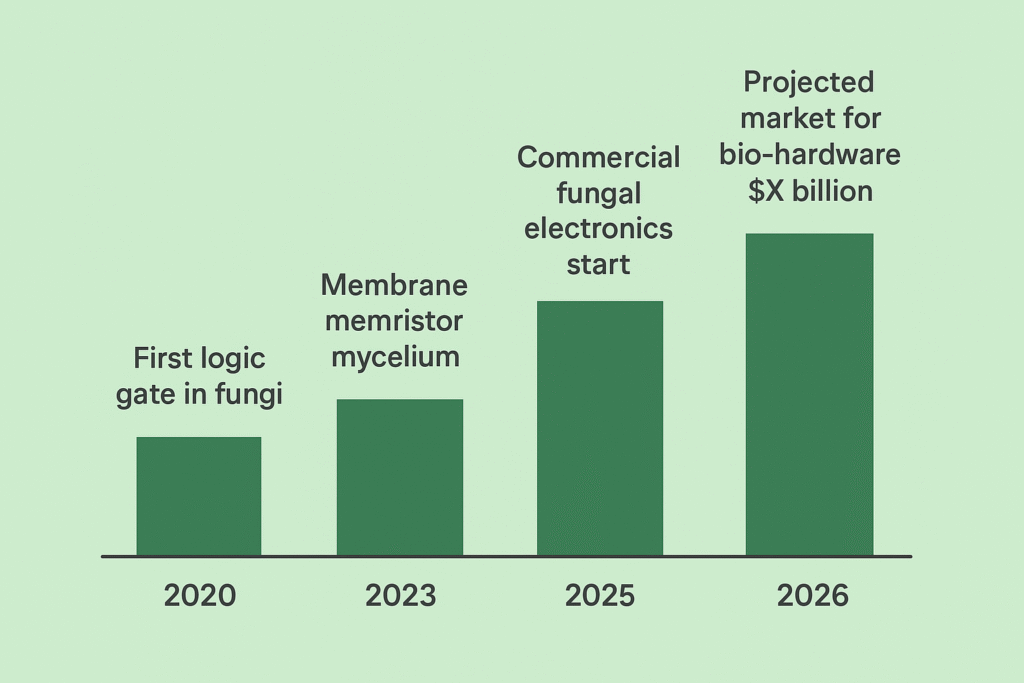Mushroom-Powered Computers: The Rise of Biologically Inspired Hardware
Introduction: From Silicon to Mycelium — A New Hardware Frontier
In the age of ever-rising computing demands and growing concerns about energy consumption and e-waste, a radical hardware shift is quietly emerging from nature’s undergrowth. Leading research laboratories across the globe are experimenting with fungi — specifically, the networks of mycelium that underpin mushroom growth — as a viable substrate for computing. These pioneering efforts suggest that one day our computers might not be made of silicon but of living networks of fungal tissue.
Mushroom-powered computers sound like science fiction, but the concept is firmly rooted in laboratory progress. Researchers have shown that mycelial networks can convey electrical signals, function as analog circuits, and even implement logical operations. In this article, we explore how fungal hardware works, why it matters, the challenges ahead, and how it might reshape the future of computing and AI infrastructure.
What Is Fungal Computing?
Fungal computing (also called fungal electronics or mycelium electronics) repurposes the natural conductive and signalling properties of fungal mycelium — the root-like network beneath mushrooms — to behave like circuits and processors. In experiments, scientists stimulate mycelial material with electrical inputs and observe voltage spikes, conductivity changes and even logic behaviour reminiscent of simple computing elements.
For instance, at the Unconventional Computing Laboratory in Bristol, UK, researchers grew networks of oyster fungi (Pleurotus species) and used them to implement AND/OR logical gates by measuring electrical spikes. The hypothesis: mycelium could become an adaptive, self-healing substrate for next-gen computing — offering low power consumption, fault tolerance and new architectures.
Why mushrooms?
Rich network topology: Mycelium can branch in complex patterns, akin to neural networks.
Electrical signalling: Fungi transmit electrical impulses in response to stimuli.
Biodegradable / sustainable: Unlike rare earth-heavy chips, fungal hardware uses organic materials.
Self-healing / adaptive: Mycelial networks regenerate and repair, providing resilience.
How It Works: From Mycelium to Logic Circuits
The process begins with cultivating mycelium on a substrate, embedding electrodes, applying electrical inputs and monitoring responses. Researchers stimulate two points in the network and measure signal propagation, spike amplitudes and delay times. Based on these parameters they can interpret “0”/“1” states, implement simple gates and identify circuit behaviour within the fungal mat.

In one experiment, after stimulation, the mycelium displayed repeatable spiking behaviour. Each spike corresponded to a ‘bit’ of information. Over time, the geometry of the network determined which logical functions could be realised. Some key findings:
Fungi can behave like memristors — resistors with memory of past states.
Mycelium bound composites display capacitive and resistive behaviours suitable for analog computing.
Real-World Breakthroughs & Applications
While still experimental, several labs report tangible milestones:
At Ohio State University, scientists created shiitake mycelium-based memristors capable of up to ~5,850 Hz operation with ~90% accuracy — a major stride toward neuromorphic hardware.
At Cornell University, researchers built biohybrid robots with mycelium embedded sensors that responded to light and chemical stimuli — hinting at bioelectronic interfaces.
In architecture/engineering, the “Fungal Architectures” project explores living mycelial substrates for computation and structural design.
These advances suggest potential applications: ultra-low power edge computing in remote environments, biodegradable electronics, adaptive materials, brain-inspired AI hardware, and hardware for space or extreme conditions (thanks to fungal resilience).

Why This Matters: Implications for AI, Web & App Development
For your agency, A Square Solutions, specialising in digital marketing, web & app development, AI-related content, this trend carries notable implications:
Hardware meets software evolution: AI models (LLMs, generative systems) will demand novel hardware architectures. Fungal computing may one day offer alternative substrates reducing reliance on conventional chips.
Eco-friendly infrastructure: As clients adopt green digital strategies, fungal hardware aligns with sustainability narratives.
Emerging development pipeline: App/web integrations may need to interface with bio-sensors, mycelium-based devices or hybrid bio-digital systems — a new frontier for UX and backend design.
Content & thought leadership: Publishing on this topic positions your blog/newsletter (“AI, Science & Beyond”) as ahead of curve in tech foresight.

Challenges & Limitations
Despite promise, fungal computing faces serious hurdles:
Speed & Scalability: Biological responses are slower than modern silicon transistors; achieving high gigahertz speeds remains a major challenge.
Environmental Sensitivity: Fungal networks can change in appearance or conductivity with humidity, temperature or substrate conditions — hard to standardise for manufacture.
Integration & Standardisation: Bridging living tissue with electronics and producing reliable, repeatable hardware remains difficult.
Commercialisation Timeline: While research is accelerating, broad commercial adoption is still years away — meaning market hype should be tempered with realism.
The Future: Roadmap for Adoption
What might the roadmap look like for biologically inspired hardware?
2025–2028: Enhanced prototypes, niche edge-computing applications (remote sensors, space, eco-bots).
2028–2032: Hybrid systems — silicon + fungal modules for low-power tasks, adaptive sensors.
2032 onwards: Potential wider deployment — bio-computation clusters, regenerative hardware, living interfaces.
As developers and marketers, preparing for this shift means keeping an eye on bio-materials, sustainable hardware, new API standards for bio-interfaces, and how hardware evolution will drive software paradigms.

Conclusion: A New Paradigm of Computation
The idea of mushroom-powered computers might sound whimsical today — but research and prototypes suggest we are witnessing the early phases of a hardware revolution. Fungi offer adaptability, resilience and sustainability in a sector hungry for both innovation and green credentials.
For tech businesses, digital agencies and marketers, recognising this shift early is wise. Hardware will shape software, AI will demand new substrates and users will value sustainability. The future of computing may not just be about smarter algorithms — it might also be about smarter biology.
To stay ahead, keep exploring, stay curious and ask: If not silicon, then what? The answer might just sprout beneath your feet.
